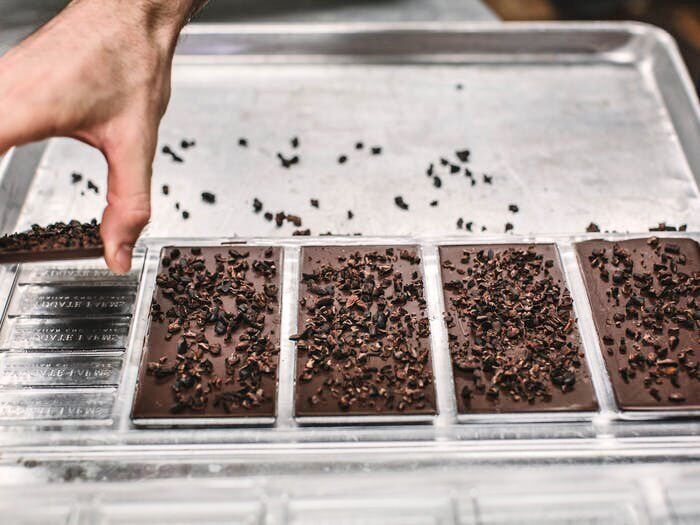How your favorite chocolate gets from branch to bar
Published 4:30 pm Tuesday, February 15, 2022

- Photo courtesy of Lydgate Farms.
Fortunately for us, there is a chocolate treat for every occasion, palate and budget. You can find it stocked in gourmet grocers and gas stations alike, but do you know how it’s made?
Will Lydgate of Lydgate Farms on the island of Kauai continues in a century-old tradition of small-scale, eco-friendly, sustainable cacao farming. The fifth-generation Hawaiian farmer’s award-winning, single-origin, branch-to-bar chocolate is created through a multi-step process that begins right on the farm.
Trending
1. Cultivation. Cacao trees require warm, humid conditions to develop, which limits the areas in which they can grow successfully to 20 degrees above or below the equator, although they really thrive in a narrow latitude within 10 degrees of the equator. The plants also need protection from wind and sun and flourish in the understories of rainforests (think: Côte d’Ivoire, Ecuador, Indonesia, Papua New Guinea). Hawaii, which is at the northern edge of the cacao-growing zone, is the only state in the U.S. that grows these tropical plants commercially.
2. Harvest. Cacao seeds are encased in eight-inch-long, football-shaped pods, which Lydgate and his team hand-harvest every 2-4 weeks throughout the year. Each pod holds roughly 20-50 cacao seeds. “Our trees produce about two to four pounds of dried cacao each year,” says Lydgate. Putting this yield in perspective, about 500 cocoa beans are needed to make one pound of bittersweet chocolate.
3. Fermentation. Cacao seeds are inherently bitter and don’t sweeten until after fermentation. To initiate this process, Lydgate collects roughly 40,000 pulp-covered, wet cacao seeds and packs them into a collection of two-by-two-foot untreated maple wood boxes. The pulpy mix works its magic for seven days, first going through an anaerobic phase that converts the cacao’s natural sugars into alcohol.
As fermentation moves into the aerobic phase, the cacao seeds naturally warm up, with temperatures reaching as high as 126°F. At this stage, the alcohol turns into vinegar-like acetic acid. Metabolic changes begin to develop the seeds’ taste, so Lydgate and team carefully watch the boxes during this phase, turning and mixing the contents to add oxygen and enhance the flavors.
“In addition to deep, rich chocolaty flavors, after fermentation we get fruity, floral notes, from banana to cherry to berry,” Lydgate shares.
4. Drying and roasting. After fermentation, the seeds are sun-dried for additional curing. Roasting boosts the seeds’ chocolate flavor and reduces any remaining moisture content, helping to loosen the thin shell from the bean within. After the roasting process is completed, Lydgate sends his dried, roasted cacao seeds to his friends at Manoa Chocolate on Oahu to complete the chocolate-making process, from winnowing to packaging.
Trending
5. Winnowing. The cacao seeds’ shells are removed and separated from the cocoa beans. Lydgate ensures that his cacao shells aren’t simply tossed away as a byproduct after this step. Instead, the farm reuses the shells in tea, chocolate extracts, cocktails and spirits. Remaining shells are composted and returned to the orchard, contributing to the ongoing lifecycle of the farm.
The crushed, cocoa beans that result from the winnowing process are called nibs and are packaged and sold or processed further to create refined chocolate.
Meet the Hawaiian cacao farmer working to change the chocolate industry
6. Grinding. Nibs are ground into a fine, pasty liquid, known as cocoa mass or cocoa liquor — this is the essential building block for making the chocolate we all know and love.
7. Tempering. Temperature fluctuations can cause chocolate to crystallize, which dulls its appearance and gives it a crumbly texture. Tempering, a carefully controlled process of heating, cooling and agitating chocolate, helps manage crystallization. Perfectly tempered chocolate has a glossy sheen and the crisp snap you hear when you break off a piece or take a bite.
8. Molding, packaging and selling. After tempering, Manoa creates Lydgate’s single-origin bars, packages them in a cellulose, biodegradable wrapper and ships them back to Kauai. Lydgate Farm’s chocolate is available at the farm, as well as through an extensive online store.

